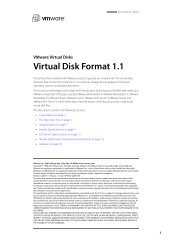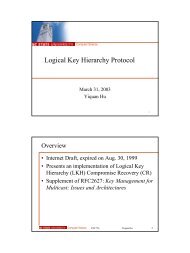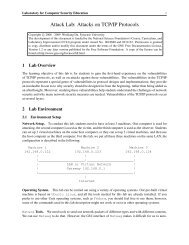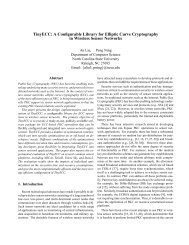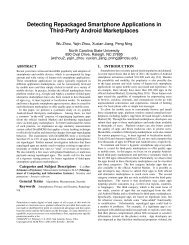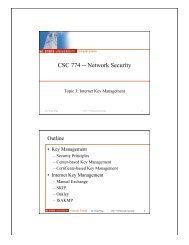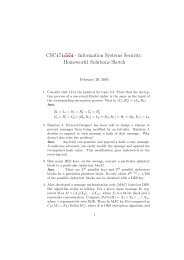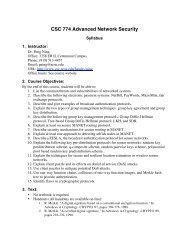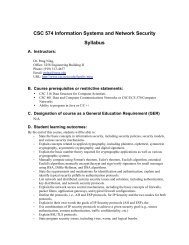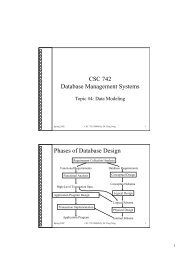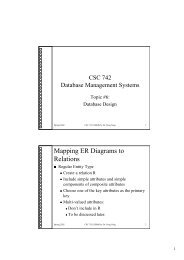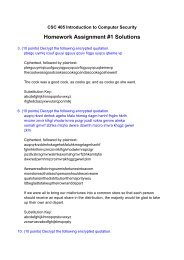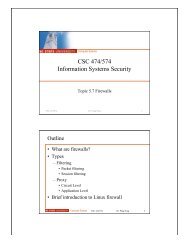A Flexible Approach to Intrusion Alert Anonymization and Correlation
A Flexible Approach to Intrusion Alert Anonymization and Correlation
A Flexible Approach to Intrusion Alert Anonymization and Correlation
You also want an ePaper? Increase the reach of your titles
YUMPU automatically turns print PDFs into web optimized ePapers that Google loves.
is that injecting uniformly distributed data generally may<br />
increase the r<strong>and</strong>omness of data sets. Also notice that the<br />
distance between PMFs <strong>and</strong> the change in global privacy<br />
are closely related because we change attribute distributions<br />
through injecting uniformly distributed data. And it is also<br />
feasible <strong>to</strong> control the number of artificial alerts through adjusting<br />
the change in global privacy.<br />
Back <strong>to</strong> artificial alert injection, if original alert set S o<br />
has m alerts, we inject n artificial alerts in it. Thus in<br />
mixed set S m including both original <strong>and</strong> artificial alerts,<br />
we have <strong>to</strong>tal m + n alerts. In S m , each individual alert<br />
m<br />
m+n<br />
n<br />
has probability<br />
m+n<br />
<strong>to</strong> be original, <strong>and</strong> probability<br />
<strong>to</strong> be artificial. So its local privacy is − ∑ p i log 2 p i =<br />
m<br />
m+n log 2 m+n<br />
m + n<br />
m+n log 2 m+n<br />
n<br />
. We can also calculate<br />
global privacy for both S o <strong>and</strong> S m , <strong>and</strong> compute their difference<br />
<strong>to</strong> see how well we can improve global privacy. One of<br />
our later experiments shows that through injecting 168 artificial<br />
alerts in<strong>to</strong> an original set with 922 alerts, we achieve<br />
local privacy with value 0.62, <strong>and</strong> we improve global privacy<br />
from 4.696 <strong>to</strong> 5.692 (the distance between two PMFs<br />
is 0.3).<br />
2.2. Scheme II: Attribute R<strong>and</strong>omization Based<br />
on Concept Hierarchies<br />
In Scheme I, we inject artificial alerts in<strong>to</strong> original data<br />
set. For any individual alert in the mixed alert set, it may<br />
be difficult <strong>to</strong> identify whether this alert is original or artificial,<br />
hence sensitive attribute values in any single alert have<br />
a chance <strong>to</strong> be faked.<br />
Let us look at Scheme I in detail. Assume that we have m<br />
original alerts, <strong>and</strong> inject n artificial alerts in<strong>to</strong> it. Hence in<br />
m<br />
m+n<br />
the mixed alert set, each alert has a probability <strong>to</strong> be<br />
original. Based on probability theory, r<strong>and</strong>omly pick up k<br />
alerts in the mixed set, the probability that at least one alert<br />
is original is 1 − (<br />
n<br />
m+n )k . As an example, let m = 1000,<br />
n = 300 <strong>and</strong> k = 2, then the probability that at least one<br />
alert is original is 94.67%, while the probability that both<br />
alerts are artificial is only 5.33%. This tells us that when the<br />
ratio of the number of artificial alerts <strong>to</strong> the <strong>to</strong>tal number<br />
of alerts is small, it is very likely that some alerts in an alert<br />
subset are original even if this subset is small. Closely investigating<br />
these small subsets may disclose the privacy of alert<br />
data. This problem may be mitigated by injecting more artificial<br />
alerts. In the extreme case, if we inject a much larger<br />
number of artificial alerts (i.e., m ≪ n), then in a r<strong>and</strong>omly<br />
selected k-alert subset, the probability that at least one alert<br />
is original may be very small even if k is big. For example,<br />
let m = 1, 000 <strong>and</strong> n = 1, 000, 000. When k = 100, the<br />
probability that at least one alert is original is only 9.51%,<br />
<strong>and</strong> even when k = 1, 000, the probability value only increases<br />
<strong>to</strong> 63.19%. Notice that with the increase of the number<br />
of artificial alerts, the usability of mixed data sets may<br />
be decreasing, <strong>and</strong> more overhead is introduced <strong>to</strong> analyze<br />
mixed alert sets. Considering privacy, usability, <strong>and</strong> performance,<br />
we propose <strong>to</strong> apply r<strong>and</strong>omization <strong>to</strong> sensitive attributes,<br />
which may allow us protect the privacy of original<br />
alerts without injecting a huge amount of artificial alerts.<br />
Notice that our r<strong>and</strong>omization algorithm takes advantage of<br />
concept hierarchies, which can preserve some useful information<br />
in sensitive attributes (e.g., prefixes of IP addresses).<br />
Though we motivate attribute r<strong>and</strong>omization in term of<br />
mixed alert sets, it can be applied <strong>to</strong> original alert sets.<br />
Given a parameter L denoting the desirable number of<br />
peers in concept hierarchies, the basic idea of our algorithm<br />
is <strong>to</strong> r<strong>and</strong>omize each different attribute value v i uniformly<br />
<strong>to</strong> any of v i ’s L-peers (In other words, the mapping<br />
<strong>and</strong> mapped values has a common general value v g<br />
where v g has L leaf nodes). For example, based on the<br />
concept hierarchy in Figure 1, we may r<strong>and</strong>omize a sensitive<br />
attribute DestIP=172.16.11.8 <strong>to</strong> DestIP=172.16.11.56<br />
if L = 256. During r<strong>and</strong>omization, we keep consistency in<br />
attribute mapping, which means if two alerts has the same<br />
original values for an attribute A s , then the mapped values<br />
for A s in both alerts are the same. For convenience, we<br />
call the mapped value the image value, or simply the image.<br />
This consistency is helpful <strong>to</strong> maintain data usability.<br />
To see how attribute r<strong>and</strong>omization may help protect<br />
alert privacy, let us take a look at both local <strong>and</strong> global privacy.<br />
Suppose that we r<strong>and</strong>omize a sensitive attribute A s in<br />
an original alert set. After performing r<strong>and</strong>omization, given<br />
any image value v r , we know the original value of v r may<br />
be any of v r ’s L-peers with equal probability (i.e., 1 L<br />
). Thus<br />
the local privacy value is − ∑ L<br />
i=1 1 L log 2 1 L = log 2 L. If we<br />
r<strong>and</strong>omize a mixed alert set, we can also derive the corresponding<br />
local privacy after considering the probability that<br />
a given alert may be original. On the other h<strong>and</strong>, based on<br />
concept hierarchies <strong>and</strong> requirements for local privacy values,<br />
we may choose desirable parameters (e.g., L) satisfying<br />
the requirements. To consider global privacy, let us assume<br />
that there are k distinct values for sensitive attribute<br />
A s in an alert set S. Since we keep consistency during r<strong>and</strong>omization,<br />
there will be at most k distinct image values<br />
for A s in r<strong>and</strong>omized alert set S r . If k distinct image values<br />
do exist, then S r have the same global privacy as in S.<br />
When less than k distinct image values are generated (this<br />
is possible because two different original values may happen<br />
<strong>to</strong> be r<strong>and</strong>omized <strong>to</strong> the same value), the global privacy<br />
value H g (S r ) in S r may change compared with the value in<br />
S, where H g (S r ) may be slightly smaller. Our later experimental<br />
results confirm this conjecture. For example, in one<br />
data set, we set L = 256, <strong>and</strong> the global privacy slightly<br />
changes from 5.692 (before r<strong>and</strong>omization) <strong>to</strong> 5.671 (after<br />
r<strong>and</strong>omization). To summarize, our attribute r<strong>and</strong>omization<br />
may result in slight change (or no change) in global privacy,<br />
<strong>and</strong> desirable change (through choosing appropriate param-<br />
5



